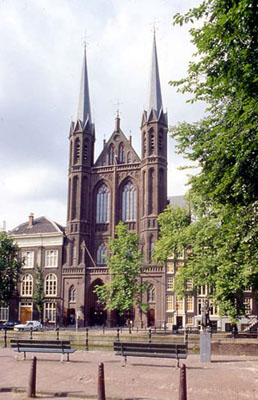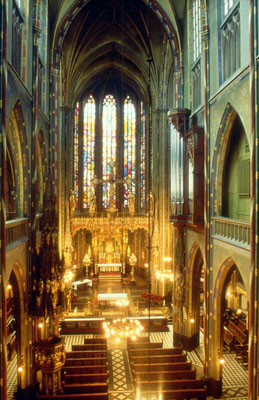 |
|

The church: De Krijtberg, Amsterdam, Netherlands.
Denomination: Roman Catholic.
The building: Spiky brick Gothic of 1883 rising up on the bank of the Singel canal. The church of St Francis Xavier, usually called the Krijtberg ("chalk hill"), is a narrow building of immense height, lavishly decorated inside with extensive polychroming, rich wood carving painted and gilded, and many, many statues, mostly of saints of the Jesuit order (to whom the church belongs). Threatened with closure, the building was designated a national monument in 1973. The ensuing and extensive restoration programme has recently been completed.
The neighbourhood: Inner city jumble of commercial and residential, small hotels, almost all within earlier narrow canal-side brick houses of historic Amsterdam.
The cast: Not named. A priest and three servers, one of whom made as if to lead the procession in, carrying a crucifix. A second priest emerged to preach the sermon, and disappeared again.
A sung mass in Latin, with plainchant sung by a choir.
How full was the building?
Moderately full: perhaps 180 in a building that could accommodate 300, though with more in the almost inaccessible galleries.
Did anyone welcome you personally?
No. There was a crush around the entrance doors, where the most popular shrines are conveniently (or should that be inconveniently?) placed. It was a case of help oneself to the leaflets – of which there were a great number in different colours, not all of them relevant to the service.
Was your pew comfortable?
Not really, as the pew seats were too shallow. Early photographs of the church show individual velvet-upholstered prie-dieus: very de luxe, and long since no doubt having passed through antique dealers' hands.
How would you describe the pre-service atmosphere?
The previous mass (also a sung mass, but with a good amateur choir which had sung a Mozart setting) was concluding. There was then a short organ voluntary followed by reasonably prayerful and expectant quiet.
What were the exact opening words of the service?
Salus populi ego sum: the introit for the day, sung by the choir.
What books did the congregation use during the service?
Missals in Latin and Dutch were supplied in the pews. Leaflets comprised a weekly newssheet, the readings in English and Dutch, and the music of the ordinary in plainchant notation.
What musical instruments were played?
The congregational parts of the plainchant were of course accompanied by a small choir organ above the singers, which made it very pleasant and encouraged participation. The choir comprised seven good singers, with a nicely nasal delivery. Unfortunately, the couturier had given them cassock-albs (with no girdles) to wear, so they looked like a convention of dentists.
Did anything distract you?
The celebrant's costume was equally unflattering and inappropriate – a shapeless green smock that he too wore over a cassock-alb.
Was the worship stiff-upper-lip, happy clappy, or what?
Modern Roman sloppy-efficient. The servers did what was needed, but without making it seem anything more than prosaic and slightly tedious. The building cried out for dozens of well-scrubbed little Dutch altar boys in lace cottas and red shoulder-capes, watched by their adoring parents. Alas, they have all left for the more salubrious suburbs.

Exactly how long was the sermon?
8 minutes.
On a scale of 1-10, how good was the preacher?
Entirely in Dutch, I understood not a word, so I cannot give it a score. The congregation showed no reaction at any point, remaining imperturbable and impassive throughout. I thought I detected some stifled guffaws behind me, but these may well have been occasioned by some distraction.
In a nutshell, what was the sermon about?
I have no idea. The Gospel reading was the parable of the unjust steward, so that should have been the topic.
Which part of the service was like being in heaven?
Worshiping in this glorious building, surrounded by the images of the saints looking down at us. Every part of the interior was decorated – either with pleasing diapering, or with statues or edifying texts. All most restful for the eye and the mind.
And which part was like being in... er... the other place?
The slovenly ceremonies. Although the celebrant had a musical voice, and everything was indeed sung (including, I was surprised, the confession at the opening), I had the feeling that the plainchant and Latin was a concession to forces of reaction in the parish, and the clergy would much rather just celebrate a said mass and get it over with as quickly as possible. There was no attempt to use the historic setting in a more positive way.
What happened when you hung around after the service looking lost?
Others went about their (fairly intense) personal devotions at the various shrines, where dozens of candles burned. Wandering round the church, I attempted to approach the Lady Altar, but was shooed away by an obviously exasperated functionary in a tweed jacket as he was trying to clear away the extensive debris of the mass (comprising in fact merely a chalice and a book). He reached for the velvet rope to prevent further incursions. It seemed very silly.
How would you describe the after-service coffee?
None was advertised, but upon entering the pastorie (clergy house) next door, the odour of hot coffee and warm conversation enveloped me. A noisy and jolly group were imbibing, and this seemed to include parishioners, and not just the choir.
How would you feel about making this church your regular (where 10 = ecstatic, 0 = terminal)?
8 – A splendid building where quite a lot seems to go on, and within the confines of inner city religion manages to embrace different strands of Catholic life. There is little choice: the centre of Amsterdam has been all but swept clear of churches. In 1969 all the city parishes were amalgamated and their buildings were condemned, closed and some even demolished.
Did the service make you feel glad to be a Christian?
Completely – and very much at home with the familiar and timeless words of the Latin mass and its traditional music.
What one thing will you remember about all this in seven days' time?
In the marble pavement in front of the communion rail were three large slabs engraved with the words Domine Non Sum Dignus– placed before one as one knelt to receive the sacrament. The identical words to those that we had said just a few minutes earlier.
| The Mystery Worshipper is sponsored by surefish.co.uk, the internet service provider from Christian Aid. By offering email services, special offers with companies such as amazon.co.uk and smile.co.uk, surefish raises more than £300,000 a year for Christian Aid's work around the world. Click here to find out how to become a Mystery Worshipper. And click here if you would like to reproduce this report in your church magazine or website. Top | Other Reports | Become a Mystery Worshipper! © Ship of Fools 2005 |